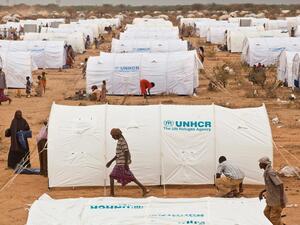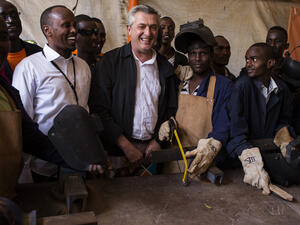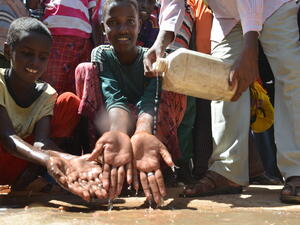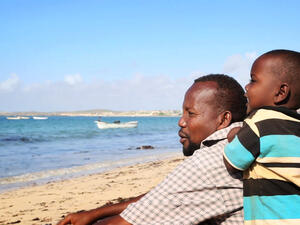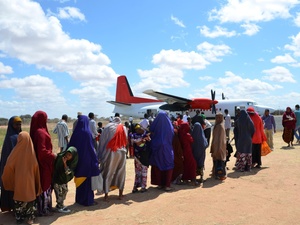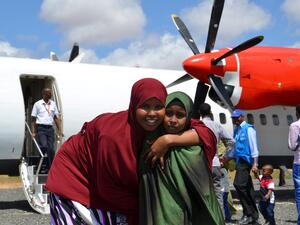Refugees arriving in Kenya amid fears of renewed fighting in Somalia
Refugees arriving in Kenya amid fears of renewed fighting in Somalia
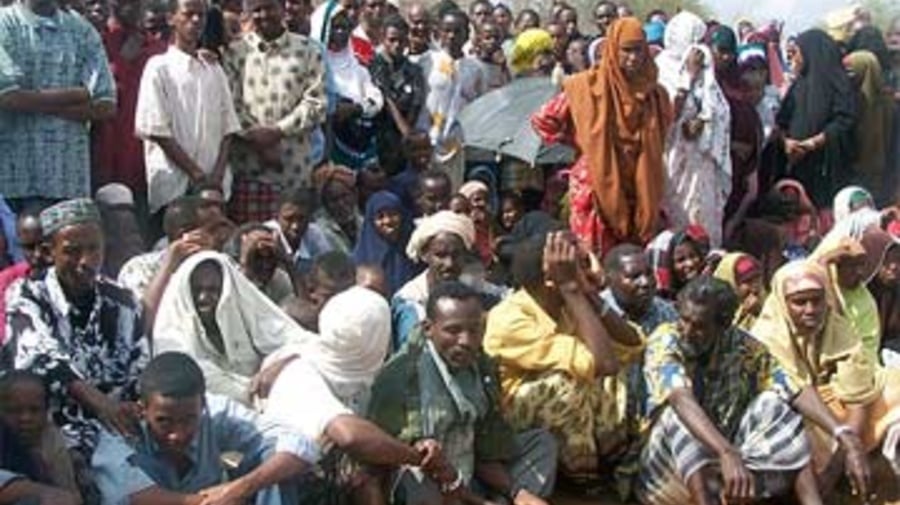
New arrivals at the Dadaab camp in Kenya. Growing numbers of Somali refugees have been arriving in Kenya in recent days.
NAIROBI, Kenya, September 15 (UNHCR) - Hundreds of Somali refugees have crossed into Kenya this week - including at least 360 on Friday alone - amid reports of an advance on the Somali port of Kismayo by fighters allied to the Islamic Courts Union.
An average of 300 Somali refugees had arrived daily at the Doble border crossing in the previous three days, and the arrivals said more were on the way. UNHCR was sending a team to investigate reports that refugees were also entering Kenya further south through the Amuma border crossing, according to Nemia Temporal, head of the UNHCR office in the Kenyan town of Dadaab.
"The rise in the number of Somalis escaping to Kenya, up from about 100 a day a month ago, has us worried that an outbreak of violence in Kismayo could trigger even more outflows," chief UNHCR spokesman, Ron Redmond, told reporters in Geneva on Friday, while noting that Kenya had already received 22,000 Somali refugees since the beginning of the year.
After crossing the Doble border crossing, the refugees are making their way to Liboi, some five kilometres away. The majority have told UNHCR field teams they are from Mogadishu and Kismayo, while a few hail from Baidoa, the seat of Somalia's interim government.
Those coming from Kismayo said they fled the port city because of rising tensions and fear of possible skirmishes between the Islamic Courts Union and warlords who have been controlling the city.
Those coming from Mogadishu and Baidoa said they feared renewed clashes in those areas. Others said they were leaving the Mogadishu area to avoid recruitment by warlords or the Islamic Courts Union.
Most of the refugees now arriving in Kenya are women and children and many are in poor condition. They are tired and markedly emaciated after travelling on foot and aboard trucks over long distances and for many days.
UNHCR is sending trucks daily to Liboi to collect the new arrivals for transfer to Dadaab, where there are three refugee camps hosting some 134,000 mainly Somali refugees.
In consultation with government authorities, the refugee agency is constructing a reception area with adequate shelter in Liboi to ensure that the refugees are protected from the weather as they await transfer to Dadaab, almost 100 kilometres away. "We are in the process of erecting tents to provide temporary shelter for new arrivals. We are at the same time trying to source building materials locally in Dadaab and Liboi," UNHCR's Temporal said.
Medical teams are also present at the border to carry out rapid screening of the new arrivals and to provide medical assistance where needed.
Temporal said the refugee agency was facing logistical problems moving the refugees. "The transfer from the border is difficult as we do not have enough trucks. We are now looking to hire trucks locally here in Dadaab to increase our capacity and to ensure that trucks bringing refugees from the border are not overcrowded," she said.
In Dadaab, UNHCR is working with the government to expand refugee sites to take in the new arrivals. While the government has shown great willingness in allocating more land for refugees, there is some resistance from the local community in Dadaab.
"The community has voiced its concern about increased numbers of refugees and possible destruction of the environment, particularly the felling of trees and bushes for construction of tukuls - the dome-shaped shelter used by Somalis. We have joined the government in talks with community leaders on this," spokesman Redmond said in Geneva.
UNHCR will also need the support of the local community to expand sanitation facilities, including putting up new stand pipes and latrines.
In all, there are 227,400 refugees in Kenya, mainly from Somalia and Sudan.
By Millicent Mutuli in Nairobi, Kenya


